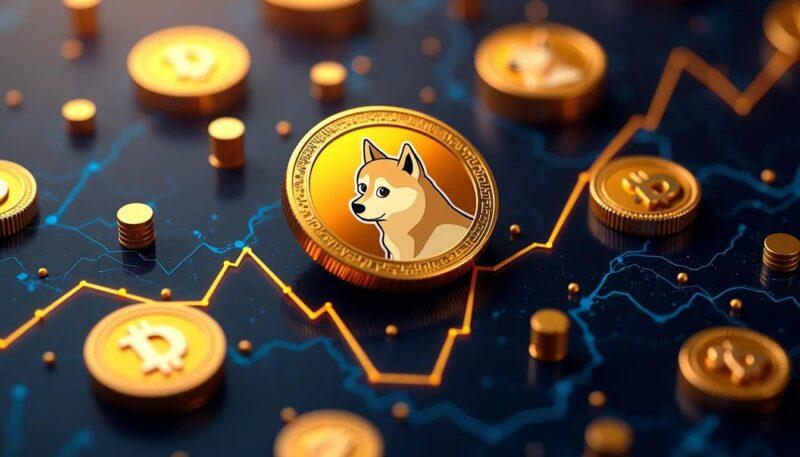In the rapidly evolving world of cryptocurrency, safeguarding your digital assets has never been more crucial. Dogecoin, once a playful meme-inspired token, has cemented its place in the crypto landscape, attracting a growing community of investors and enthusiasts alike. But with increasing popularity comes heightened risk-cyber threats loom large, and a single vulnerability could mean losing hard-earned coins. Enter Two-Factor Authentication (2FA), a simple yet formidable shield that adds an essential layer of security to your Dogecoin wallet. In this article, we explore the power of 2FA protection, unravel how it works, and demonstrate why it’s an indispensable tool in keeping your Dogecoin safe from prying eyes.
Understanding the Risks Facing Your Dogecoin Wallet
Your Dogecoin wallet is more than just a digital repository; it’s the gateway to your cryptocurrency assets and, unfortunately, a prime target for cyber threats. One of the most significant dangers comes from phishing attacks, where malicious actors disguise themselves as legitimate services to steal your login credentials. Without adequate safeguards, a simple slip can lead to irreversible loss of your Dogecoin holdings.
Another risk stems from weak or reused passwords. Many users adopt passwords that are easy to remember but equally easy for hackers to guess or crack using automated tools. In fact, attackers often leverage leaked credentials from unrelated breaches to gain access to wallets, putting your digital assets at serious risk. Add to that the dangers of malware, which can silently record keystrokes or screenshot your credentials, and the vulnerability landscape broadens dramatically.
Here’s a quick rundown of common risks that threaten your wallet security:
- Phishing scams exploiting fake websites and emails.
- Password reuse across multiple platforms.
- Malware infections such as keyloggers and clipboard hijackers.
- Insecure Wi-Fi networks enabling interception of sensitive data.
- Unauthorized device access from lost or stolen hardware.
| Risk | Impact | Preventive Action |
|---|---|---|
| Phishing | Credential Theft | Verify URLs, enable 2FA |
| Weak Password | Brute Force Access | Use strong, unique passwords |
| Malware | Data Capture | Install antivirus, avoid links |
| Unsecured Wi-Fi | Data Interception | Use VPN, avoid public Wi-Fi |
| Device Loss | Unauthorized Access | Encrypt device, enable locks |
Choosing the Right Two Factor Authentication Method
When it comes to fortifying your Dogecoin wallet, not all two-factor authentication (2FA) methods offer the same level of security and convenience. The ideal choice depends on balancing robust protection with ease of use, ensuring your assets remain safe without complicating access. Hardware tokens, for instance, provide exceptional security by storing codes offline, but they may not always be practical for everyday transactions. Meanwhile, authenticator apps strike a sweet spot by generating time-sensitive codes directly on your phone, combining both security and accessibility.
Consider these common 2FA options and their unique strengths:
- Authenticator Apps: Popular choices like Google Authenticator or Authy provide dynamic codes, are offline-capable, and resist SIM swapping attacks.
- SMS-Based Verification: Convenient but vulnerable to interception and number porting scams; best avoided for high-value wallets.
- Hardware Tokens: Devices such as YubiKey offer superior security through physical presence but require investment and careful handling.
- Biometric Authentication: Utilizing fingerprints or facial recognition can add a seamless second layer but depends heavily on device security protocols.
| 2FA Method | Security Level | Convenience | Ideal Use Case |
|---|---|---|---|
| Authenticator App | High | Moderate | Daily wallet access |
| SMS Verification | Low | High | Low-risk accounts |
| Hardware Token | Very High | Low | Long-term savings storage |
| Biometrics | Medium | High | Mobile wallet access |
Step by Step Guide to Enabling 2FA on Popular Wallets
Activating two-factor authentication (2FA) on your Dogecoin wallet significantly enhances your security by requiring a second layer of verification beyond just a password. Most popular wallets incorporate 2FA options either directly within their settings or by supporting external apps like Google Authenticator or Authy. Start by navigating to the security settings of your wallet, often found under account or privacy sections. Look for options labeled “Two-Factor Authentication,” “2FA,” or “Multi-Factor Authentication.”
Once in the 2FA setup area, the next step usually involves linking your wallet to an authentication app. This process might include scanning a QR code or entering a unique key manually, which you then use to generate time-limited codes ensuring that only you can access the wallet. Be sure to safely store any backup codes provided during this phase, as they are crucial to regain access if your authentication device is lost or compromised. Below is a quick checklist to keep in mind during setup:
- Verify your contact details such as email or phone number for recovery purposes.
- Scan the QR code carefully with a trusted authentication app.
- Save backup codes in a secure offline location.
- Test login by logging out and signing back in using the 2FA code.
| Wallet | 2FA Support | Setup Time | Recommended App |
|---|---|---|---|
| Exodus | Yes | 5 minutes | Authy |
| Atomic Wallet | Yes | 3 minutes | Google Authenticator |
| Coinomi | Yes | 4 minutes | Microsoft Authenticator |
Best Practices to Maintain Strong 2FA Security
Strengthening your two-factor authentication starts with selecting the right app or device. While SMS-based 2FA is better than none, it’s vulnerable to SIM swapping and interception. Opt for authenticator apps like Google Authenticator, Authy, or hardware tokens such as YubiKey. These tools generate time-sensitive codes that provide an extra layer of protection, making unauthorized access significantly harder for hackers.
Regular updates and vigilance are crucial to keep your 2FA mechanisms effective. Always ensure your authentication apps and devices are updated to the latest versions to patch security vulnerabilities. Moreover, monitor your account activity frequently-any unexpected login attempts should prompt an immediate change of credentials and a review of your 2FA settings.
To further safeguard your Dogecoin wallet, consider these essential habits:
- Backup your 2FA codes: Store recovery keys securely offline; losing access to your authenticator app without backup can lock you out permanently.
- Use unique passwords: Avoid password reuse and pair strong passwords with your 2FA for a double shield.
- Beware of phishing: Never enter your 2FA codes on suspicious websites or share them through email and messaging apps.
| Common 2FA Methods | Security Level | Pros | Cons |
|---|---|---|---|
| SMS Codes | Moderate | Easy to use | Susceptible to SIM swaps |
| Authenticator Apps | High | Time-limited codes, no network required | Device loss risks |
| Hardware Tokens | Very High | Physical device, strong security | Cost and convenience |
What to Do When Your 2FA is Compromised
Discovering that your two-factor authentication (2FA) has been compromised can feel like a breach of your last line of defense. The first step is to act swiftly – immediately disable the affected 2FA method on all your accounts where it’s enabled. Don’t wait to receive suspicious alerts; preemptively logging out of all devices and resetting your account passwords is essential to contain any potential damage. Always opt for the strongest passwords possible to complement your 2FA measures.
Next, evaluate the security of your authentication tools. If you’re using an app-based 2FA, reinstall the authenticator app and re-scan QR codes provided by your services. In case of hardware tokens, report the loss or compromise to the manufacturer and request a replacement. It’s also wise to scan your devices for malware or spyware that might have captured your authentication codes. For added safety, review account activity logs for any unauthorized access attempts and notify the platform’s support team if necessary.
Here’s a quick checklist to keep handy when you suspect a 2FA breach:
- Disable compromised 2FA immediately.
- Change all related account passwords.
- Reinstall or replace authentication apps or hardware.
- Scan devices for threats.
- Review account activity logs carefully.
- Contact support for further assistance.
| Step | Action | Reason |
|---|---|---|
| 1 | Disable 2FA | Prevent further unauthorized access |
| 2 | Change Passwords | Invalidate stolen credentials |
| 3 | Reinstall Authenticator | Restore secure 2FA setup |
| 4 | Device Malware Scan | Detect hidden threats |
| 5 | Check Activity Logs | Identify suspicious behavior |
Q&A
Q&A: Securing Your Dogecoin Wallet – The Power of 2FA Protection
Q1: What is Two-Factor Authentication (2FA), and why does it matter for my Dogecoin wallet?
A: Two-Factor Authentication, or 2FA, is an extra layer of security added to your wallet login process. Instead of relying solely on your password, 2FA requires a second form of verification-usually a temporary code sent to your phone or generated by an app. For your Dogecoin wallet, this means even if someone steals your password, they still can’t access your funds without that second piece of information. It’s like having a double lock on your treasure chest.
Q2: How does enabling 2FA protect my Dogecoin compared to just having a strong password?
A: While a strong password is your first line of defense, it’s not impervious. Hackers use phishing, keylogging, or data breaches to steal passwords. 2FA acts as a safety net-adding a dynamic code that changes every 30 seconds or so. Even if a hacker knows your password, without access to your 2FA device or app, your Dogecoin remains secure. In essence, 2FA turns your wallet into a fortress with two gates.
Q3: What are the common types of 2FA methods available for protecting Dogecoin wallets?
A: The most common 2FA methods are:
- Authenticator apps (e.g., Google Authenticator, Authy): These generate time-based one-time passwords (TOTPs).
- SMS codes: A code sent via text message to your phone.
- Hardware tokens: Physical devices like YubiKey that generate or confirm codes.
For the best security, authenticator apps or hardware tokens are recommended over SMS, which can be vulnerable to interception.
Q4: Can enabling 2FA make accessing my Dogecoin wallet inconvenient?
A: While it adds an extra step, 2FA is designed to be quick and user-friendly. Entering a short, temporary code is a small trade-off for significantly enhanced security. Think of it as a brief checkpoint ensuring your wallet’s safety. Once you get used to the rhythm, it becomes second nature-much like unlocking your phone with a fingerprint.
Q5: What precautions should I take when setting up 2FA for my wallet?
A: First, save your backup codes safely. These codes let you regain access if you lose your phone or 2FA device. Second, avoid using SMS-based 2FA if possible, due to risks of SIM swapping. Third, keep your authenticator app or hardware token secure and private. Lastly, never share your 2FA codes or password with anyone-not even someone claiming to be support.
Q6: If I lose access to my 2FA device, can I still get into my Dogecoin wallet?
A: Yes-provided you’ve saved your backup codes or set up recovery options offered by your wallet service. Without backups, regaining access can be complicated or even impossible, so preparation is key. Treat those backup codes like precious gems-store them somewhere safe, offline, and accessible only to you.
Q7: Is 2FA effective against all types of cyber attacks targeting Dogecoin wallets?
A: While 2FA significantly reduces the risk of unauthorized access, it’s not foolproof. It protects primarily against password theft but doesn’t prevent malware, phishing scams, or social engineering attacks entirely. Complement 2FA with other good practices-like keeping your software updated, avoiding suspicious links, and using hardware wallets for large holdings.
Q8: How can I encourage more Dogecoin users to adopt 2FA?
A: Education is the key. Share stories and facts about security breaches prevented by 2FA. Highlight that protecting your crypto is not just about tech-it’s about preserving trust, value, and peace of mind. Encourage the community to view 2FA not as a hassle, but as a digital guardian for their Dogecoin stash.
Securing your Dogecoin wallet with 2FA is more than a step-it’s a mindset. It’s about recognizing that in the wild west of cryptocurrency, a double lock keeps your coins safe from unwanted hands. Embrace 2FA, and let your Dogecoin journey be as secure as it is exciting.
Key Takeaways
In the ever-evolving landscape of digital currencies, safeguarding your Dogecoin wallet is more than a smart move-it’s essential. Two-factor authentication stands as a steadfast guardian, adding a critical layer of security that transforms vulnerability into confidence. By embracing 2FA, you’re not just protecting your coins; you’re investing in peace of mind. As you continue your Dogecoin journey, let this simple yet powerful tool be your shield against threats, ensuring that your digital treasures remain firmly in your paws.






